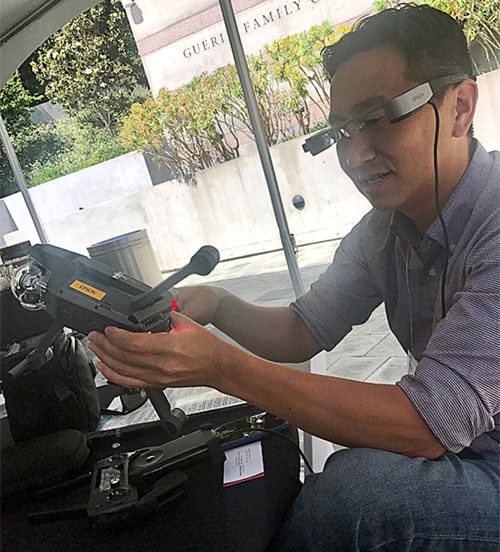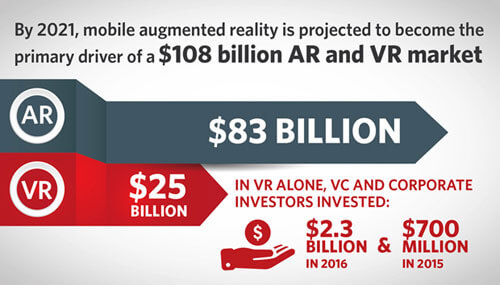Entertainment
Augmented Reality: Business Opportunities in the Real World
By Melody Yuan
 AR will change the way we do everything in the near future. (Photo credit): Gettyimages.com/Yagi-Studio
AR will change the way we do everything in the near future. (Photo credit): Gettyimages.com/Yagi-Studio
From drones to apps: How augmented reality (AR) is an effective tool across industries.
Smart cars with screens that tell you the cost of gas every time you pass a gas station, virtual fitting rooms that let you try on clothes from your phone, and having your favorite video game character come to life in your living room—these are only a few examples of AR applications today. Things we had only dreamt about are now becoming part of our reality.
AR is growing, but what exactly distinguishes this technology from virtual reality (VR) and other forms of mixed reality? Think of it this way: while VR can immerse and transport you into a completely different universe, AR applies computer-generated images onto the real world and provides a composite view of the user’s surroundings. With AR, the real world becomes digitally interactive and loaded with virtual information, and businesses are jumping on the bandwagon to use this technology.
The Zion Research Analysis from 2016 shows that by 2021, augmented reality will generate industry revenue of $133.78 billion. The current market already has a number of players that have introduced patented hardware and software. The number of apps developed for AR on mobile and head mount display (HMD) platforms are growing exponentially. Areas that still have room for experimentation include live events and head up display (HUD) platforms. In short, the future that we had all been excitedly waiting for has arrived.
Trailblazing businesses in the realm of mixed reality
Apple just announced its launch of ARKit, a visual-inertial tool that emphasizes “world tracking” and is comparable to Google’s Tango platform. The ARKit framework will allow developers to build more apps with AR capabilities, and encourage consumers to take digital information and blend it with their environment. Another success story in AR adoption by the mass market and common user is Pokemon Go!, a version of Niantic’s popular game from the ‘90s that took everyone by a frenzy and allowed people to catch Pokémon in the real world. Snapchat, a popular social media app, also regularly uses AR applications with simple features such as animating a user’s face, or adding doodles and stickers to pictures that users take in real-time. The Google Translate app has an AR feature that helps translate physical text simply by turning on the app’s camera mode and scanning the text to get real-time translations for up to 13 languages. Wikitude World Browser, a relative to the popular digital encyclopedia Wikipedia, allows users to scan their geo-referenced content to discover restaurants, stores, attractions, and information/history of their surroundings. There is also a new AR concept in airports, which has been getting a lot of public attention. Most recently, the U.K.’s Gatwick Airport installed 2,000 beacons to help travelers find their gates and navigate the airport smoothly via an AR feature on their airport app.
“AR will change the way we do everything in the next five years,” says Timothy Dodd, senior vice president of Technicolor. “From marketing and travel, to live events and entertainment, we’re in for a ride.”
Eric Mizufuka, manager of New Ventures at Epson America Inc., shares the company’s most recent product launch: Epson’s Moverio Drone. Combining drone capabilities with smart eyewear, the Moverio Drone’s AR platform is designed to help businesses in a number of different ways. The drone is powered by the Android 5.1 OS and runs on a quad-core Intel Atom X5 processor—which all means that this technology is fast and user-friendly for the public. The drone is built with a front-facing camera and sensors that allow pilots to see things from the drone’s perspective using smart glasses. With developers able to create life-like 3D AR experiences, pilots can fly with more accuracy and real-time views captured by the drone.
"The challenge we face today is in creating a natural user interface for this technology."

“Now in our sixth year in the AR eyewear space, Epson’s Moverio platform has driven interest, and you can see the consumer demand. Our sales increase exponentially, year after year,” says Mizufuka. “We’re especially excited to be partnered with DJI to make flying a safer and more productive experience. We believe that piloting unmanned aerial vehicles (UAVs) is one of our killer applications.” DJI stands for Da-Jiang Innovations Science and Technology Co. Ltd, a leading technology company investing in the advancement of drones and aerial photography headquartered in Shenzhen, China.
How to get higher consumer adoption rates
“Mobile is the most pervasive device that we already use today,” says Michael Leventhal, partner of Holmes Weinberg P.C., and former chief legal officer and vice president of Magic Leap. “But really, AR is everywhere, in everything, and, as the technology develops, the possibilities will be limitless.” One method for AR exposure that he mentions is the B2B2C model, which essentially calls for AR tech companies to partner or sell software and hardware to existing consumer brands. From there, early adopters and brand ambassadors can push the product into the mainstream consumer market. “The key is to ease consumers into new applications,” advises Leventhal. “Integrate your product into familiar objects, services and functionalities.”
Schools and various educational facilities, from flight schools, to hospital training programs, are also incorporating AR into their curriculums. Within the next few years, the market predicts that consumers will become more used to mixed reality as the technology simultaneously advances. Mixed reality device shipments worldwide are forecasted to grow from 10.1 million shipments in 2016 to more than 110.5 million units by 2020.

The next business opportunity in AR
“The challenge we face today is in creating a natural user-interface for this technology,” says Mizufuka. Despite its fast growth, AR developers and businesses alike lack a universal interface that allows for seamless interaction and consumer use. Whether that’s in app development, or software used by theme parks worldwide, finding a creative solution or platform that allows businesses to seamlessly communicate and build their AR applications, while encouraging consumers to adopt the technology easily, has remained a challenge. “There are so many different platforms that aren’t talking to each other,” says Leventhal. “We need to build a platform where people can come with their native devices and still integrate seamlessly.”
While the solution to a better interface will undoubtedly result from trial and error, combined with the time required for the evolution in mixed reality, the first individual or business to offer a solution will be sure to reap immediate benefits.
Other areas of opportunity are predicted to come from identifying ways to encourage higher AR adoption rates from consumers, and finding solutions to existing software and hardware gaps in the technology. This includes developers exploring ways to transition the technology from a content consumption end to a more user content creation format. This user-focus also highlights the need for better social interaction platforms to spur others to join their friends and families on mixed reality domains. Because the technology is still in its nascent stages, revenue streams and ideas for in-experience monetization are still being explored. Staking claims in any of the areas above will bode well for any entrepreneur or business looking to add value to the AR/VR and mixed reality industry.
Read more tech and innovation stories
Sign up for the Reach Further Newsletter
We’ll keep you in the know about the latest US-Asia business news and trends.
Suscríbase al boletín Reach Further
Lo mantendremos informado sobre las últimas noticias y tendencias comerciales entre Estados Unidos y China.

